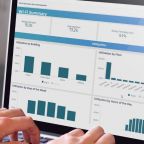For businesses and universities alike, the traditional workplace model has been turned upside down. The COVID-19 pandemic forced all types of employees, faculty, and staff—including roles that had always been in-person—to work remotely. Many employees really liked their experience working from home and want to continue in some capacity. That’s why organizations are looking for new ways to support their transition to a hybrid workplace model including the active redesign of physical spaces and the adoption of more digital processes and tools.
According to a poll conducted during the first part of our “Building Confidence out of Chaos” webcast series last month, we learned that 56% of organizations are pursuing a combination of assigned and reservable space as part of their new workplace strategy. Twenty-three percent said that all employees are assigned to workstations and only 7% said all employees are fully remote.
In this article, we’ll summarize some key points from our webcast Q&A with Cheryl Benningfield, Space Planning Manager at the University of North Texas (UNT). Learn how she uses technology to manage 8 million gross square feet of fully occupied space as UNT navigates the transition to a hybrid workplace. Plus, discover how UNT was able to increase productivity 94% in three years.
Managing unpredictability and shifting workforce attitudes
UNT is one of Dallas-Fort Worth’s largest and most comprehensive universities. It is a Carnegie Tier One public research university with roughly 1,600 faculty members and 3,000 staff working within 14 colleges, a satellite campus, and a high school academy. Benningfield manages more than 8 million square feet and 178 buildings.
Similar to many universities, the culture at UNT before March 2020 was that every employee had an assigned place to work. Today, they take a percentage-based approach to workspace assignments. For example, if a worker is on campus 60% of the time, they have an assigned workspace; if they are only on campus one or two days per week, that employee will transition to a shared workspace. However, as Benningfield notes, “We have 5,000 plus employees and it’s a big ship to turn. So, it’s a work in progress.”
When UNT first started bringing employees back to campus, Benningfield sent out a survey to gather feedback. She got HR involved in the process to help define policy for remote working arrangements. At first, many employees did not want to give up their assigned space on campus. Since then, employee attitudes have evolved to “seeing the advantage to having a more flexible workplace and they’re more readily willing to adapt to different styles of workplaces,” she said. “I just can’t stress enough that you have to keep asking these questions over and over again. It’s not a one-time assessment.”
As UNT’s space planning manager, Benningfield is committed to supporting the university’s transition to the hybrid workplace model. “We don’t have a choice; we have to offer these options. We will lose talent if we don’t offer virtual or partially virtual options for employees,” she pointed out.
Visibility and insight aids space management
We asked Benningfield if there was anything that gave her an advantage as the university pivoted from in-person to remote and then to hybrid. Without hesitation, she said that having FM:Systems in place before all this disruption occurred has been vital to their success.
“You guys [FM:Systems] are the only solution. The amount that we can accomplish with it at this point would be really hard to match elsewhere. This is where everything started from our system. All of the data came from it. This is how everybody knows where everybody sits. You can pull their locations, their job description, their roles, and everything out of the system and look at it.”
-Cheryl Benningfield, Space Planning Manager, University of North Texas
With a campus that is currently 99.8% occupied, having that information at her fingertips is critical to success. Even the space that’s not occupied already has a plan. With FM:Systems, Benningfield can leverage dashboards with data visualizations to get a clear picture of current vacancies and ownership breakdowns to allocate space properly and implement change.
Increasing the productivity of space
Another topic discussed in the webcast was the ability to track and monitor the level of productivity UNT gets out of their research space. Universities like UNT leverage FMS:Workplace as a single source of truth for information about their research space—including the ability to track the dollars per square foot for research space by principal investigator (PI).
Benningfield points out, “It has been hugely successful. We increased our productivity 94% in three years.” She chalks up the gains to improved reporting about how space is being used, which enables them to maximize utilization. Using this information, UNT takes advantage of opportunities to group research into spaces where PIs can share resources to keep costs down. Additionally, they can split time so that the actual research is done physically in the lab, but the computational part of it can be done remotely through high-speed research computing in the cloud.
Real-world results: Hear first-hand how organizations are adapting to hybrid workplace trends
In terms of space planning management, “We’re very much a part of big decisions…Basically, the campus has become very reliant on what we do. Leadership can’t make day-to-day decisions without technology, if they do, they will get caught by not looking at the data,” Benningfield concluded.
Join us as we continue this 3-part webcast series, “Building Confidence out of Chaos”. We’ll explore what organizations are doing to manage a change in trends in the digital workplace and optimize real estate portfolios. Plus, we’ll share best practices to help guide you through your organization’s transition to a hybrid workplace model.











